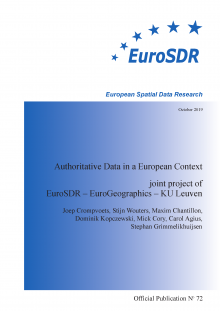Official Publication No. 72 (2019)
Societies are increasingly digitalizing more and more aspects of daily life. A basic building block for digitalization is data. This data is being integrated within and across public administrations, but also across borders and across the public, private and not-for-profit sectors. High quality data is a necessary criterion to ensure the quality of both public and private digital services and to drive innovation (Debruyne et al., 2017; European Commission, 2016).
The recognition and organization of data as authoritative should be vital not only for ensuring the data quality, but also to foster trust between public sector organizations, between different sectors and across borders (European Commission, 2017). Especially in the context of geospatial data, the exchange and integration of authoritative data has advanced significantly. Important challenges however still need to be addressed (Cravens & Ardoin, 2016).
Authoritative is a term that one often sees or hears when someone is describing geospatial data. Many public mapping, cadastral and land registration agencies promote their geospatial data as authoritative or as created from authoritative sources. Although authoritative data sounds impressive, it is important to understand what it really means. In a geospatial context, land surveyors were probably the first to use the term authoritative geospatial data and they have been producing authoritative data for some time. Surveyors define authoritative as data that contains a surveyor’s professional stamp and that the data can be used for engineering design, determination of property boundaries and permit applications. In essence, the term carries a certification of positional accuracy (Plunkett,
2014).
For decades, if not centuries, national mapping, land registries and cadastral authorities (NMCAs) have been recognized as the official source of geographic information. They were established by states to collect and distribute geospatial (mapping) and map-related data, often for some defined public purpose, such as defence, taxation or protection of property rights. The data provided by these public authorities were habitually presented as authoritative data.
Today, NMCAs are not the only ones providing geospatial data, information and related services. A growing number of different producers and providers of geospatial data, information and services are entering the market, serving different purposes and needs vis-àvis the users, who are both private and publicly oriented. These new data, information and service producers/providers come from the public, private and community sectors. With this development in mind, there is a need for setting a clear understanding of what is meant by authoritative. When exploring the meaning of the term authoritative geospatial data, issues related to legislation, trust, and certification emerge. The term might be applied only to data that is legislated or regulated. If it is necessary to differentiate data supplied by government agencies from other sources of data, then it is suggested that the discussion should be about trusted data, and what gives rise to such trust. The validation of this type of data might be part of the certification of authoritativeness. For most practitioners, the term usually somehow refers to data that was produced or is approved by some authority.
Besides the meaning of the term, there is also no proper understanding what the added value of authoritative geospatial data is and which policies lead to its successful use. It is also not fully clear how the term is applied and interpreted across Europe. Under different national conditions ‘authoritativeness’ can be defined in various ways.
The main objective of this report is twofold: 1) to provide a better and more comprehensive understanding of the definition of authoritative data, its rationale, added value(s), challenges, policies, and the organization of authoritative geospatial data across Europe; and 2) to help NMCAs to better produce and sustain the usage of authoritative geospatial data in the (near) future. Moreover, it might enhance a better communication amongst NMCAs about the generic meaning of the topic.
An online survey was undertaken in the summer of 2018 to get an overview of the meanings, interpretations, policies and usages of authoritative data across Europe. A questionnaire was sent to all members of EuroGeographics, who are the national mapping, land registry and cadastral authorities (NMCAs) of Europe. The first results were presented at the General Assembly of EuroGeographics in Prague (October 2018). During the General Assembly, focus group meetings in the form of roundtable discussions were organised that built on the findings of the survey and delved into the challenges, benefits and opportunities of authoritative data. This report presents the results of the online survey as well as the focus groups meetings.
After this short introduction, the followed methodologies of the online survey and focus group meetings are described in Section 2. In Section 3, the results of the online survey and focus group meetings are presented. Section 4 ends with a discussion of the results, while section 5 provides a conclusion. Whereas the authors opted to include a detailed and complete overview of the results in Section 3, the discussion and conclusion section should allow the reader to gain an understanding of the overall topic, the main conclusions and the discussion points.

